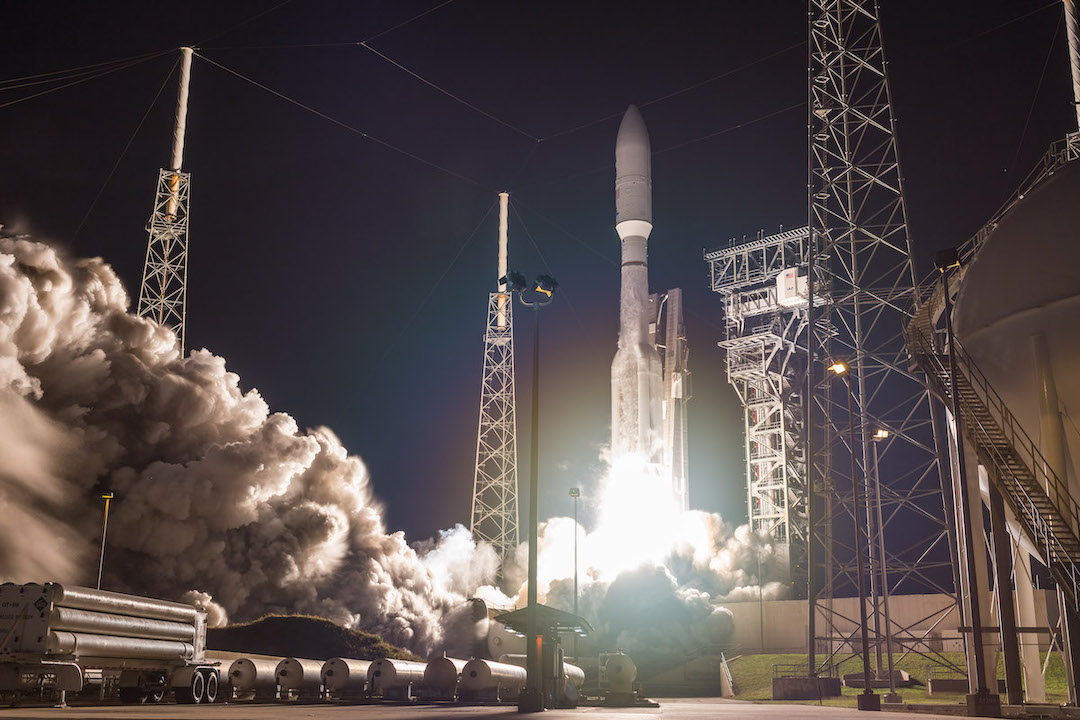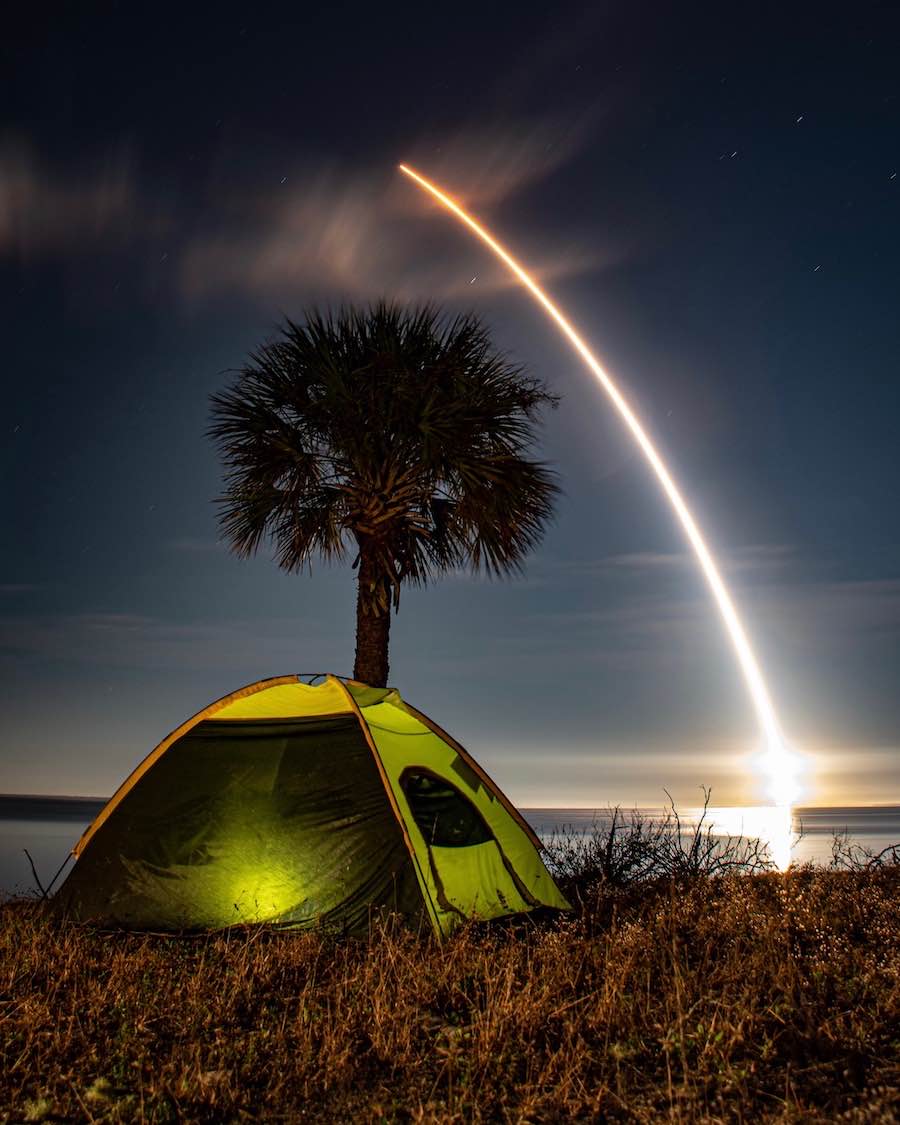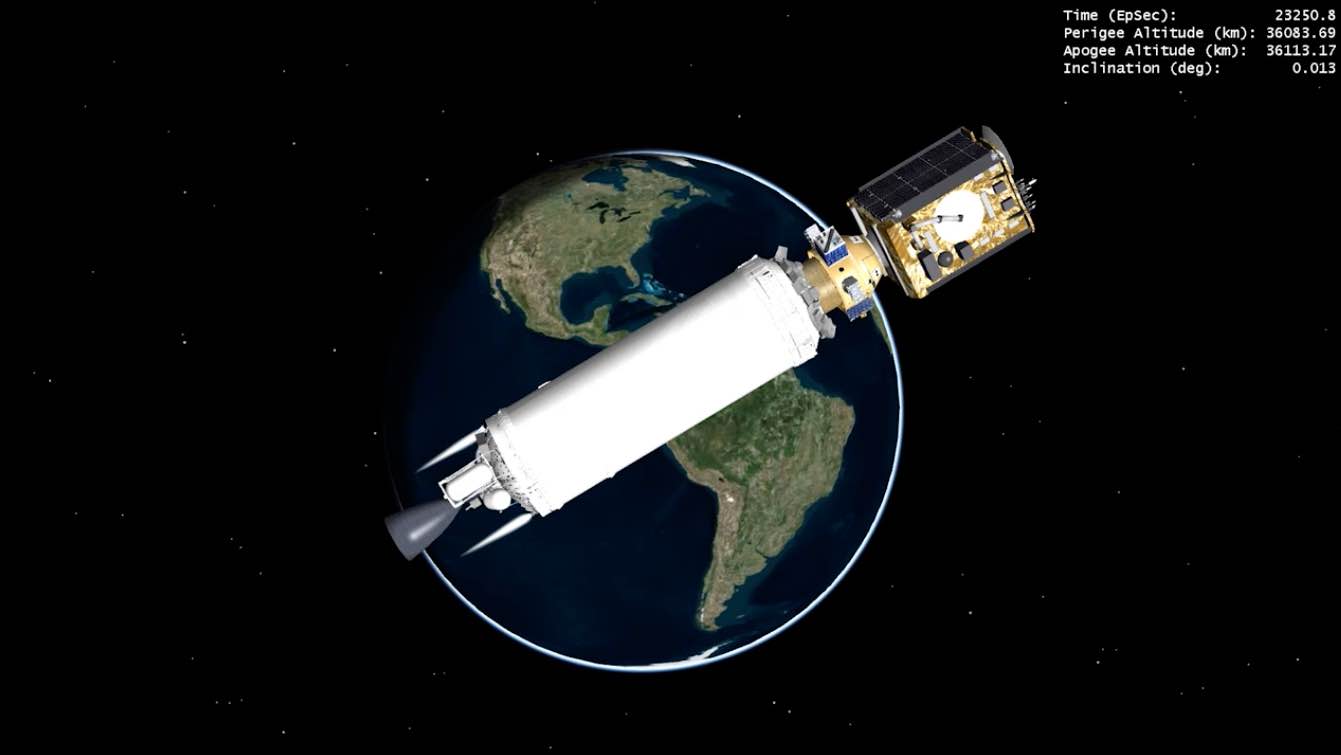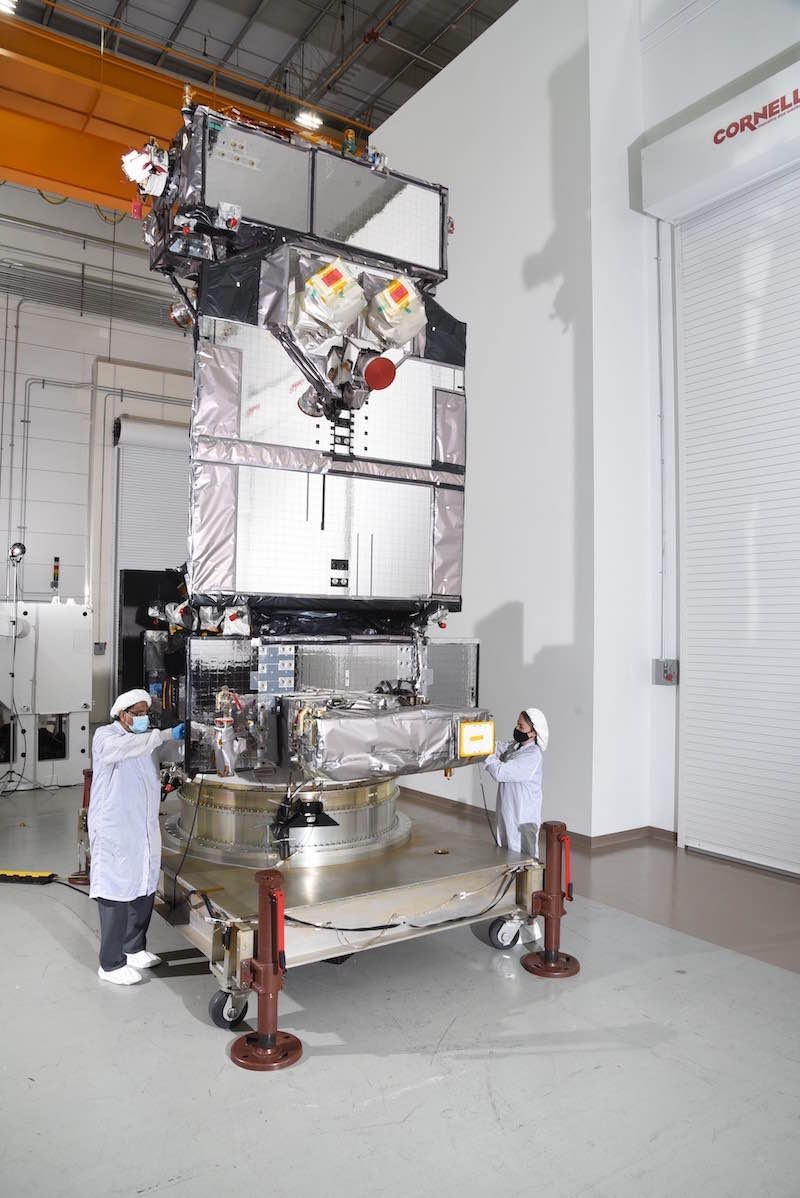Space News & Blog Articles
Atlas 5 rocket launches Space Force tech demo satellites on marathon mission
 United Launch Alliance’s 90th Atlas 5 rocket lifts off with the Space Force’s STP-3 mission. Credit: Alex Polimeni / Spaceflight Now
United Launch Alliance’s 90th Atlas 5 rocket lifts off with the Space Force’s STP-3 mission. Credit: Alex Polimeni / Spaceflight Now
United Launch Alliance deployed two U.S. Space Force technology demonstration satellites into an on-target orbit more than 22,000 miles over the equator Tuesday after a booming blastoff before dawn from Cape Canaveral on an Atlas 5 rocket.
The successful mission, which the Space Force said was valued at $1.14 billion, delivered a medley of experiments in laser communications, weather monitoring, and space situational awareness, plus a government payload to detect nuclear detonations to ensure compliance with international test ban treaties.
The 196-foot-tall (59.7-meter) Atlas 5 rocket took off from launch pad 41 at Cape Canaveral Space Force Station at 5:19 a.m. EST (1019 GMT) Tuesday. ULA delayed the launch more than an hour to wait for improved upper level wind conditions.
The mission was previously postponed from Sunday after ULA teams detected a kerosene fuel leak in the launch pad’s ground storage system that prevented the start of the Atlas 5 countdown.
With an assist from five solid rocket boosters, the Atlas 5 catapulted off pad 41 and thundered into a clear predawn sky, heading east over the Atlantic Ocean with 2.6 million pounds of thrust. The Atlas 5 flew on its 90th mission, and the 12th in its most powerful configuration with a full complement of solid-fueled motors.
The rocket’s Centaur upper stage ignited an Aerojet Rocketdyne RL10 engine nearly five minutes into the mission to reach a parking orbit, then reignited more than an hour after launch to raise the apogee, or high point, of its orbit more than 22,000 miles (about 36,000 kilometers) above Earth.
The rocket then coasted five hours before firing the RL10 a third time to circularize its orbit near geosynchronous orbit roughly 22,400 miles (36,100 kilometers) above the equator.
Finally, six-and-a-half hours after departing Cape Canaveral, the Centaur upper stage deployed the Space Force’s STPSat 6 satellite. Forty minutes later, at T+plus 7 hours, 10 minutes, the upper stage released a rideshare payload named the Long Duration Propulsive ESPA, or LDPE 1.
Both spacecraft were manufactured by Northrop Grumman, and carry an array of technology demonstration payloads.
 An Atlas 5 rocket streaks into the sky over Cape Canaveral early Tuesday. Credit: Michael Cain / Spaceflight Now / Coldlife Photography
An Atlas 5 rocket streaks into the sky over Cape Canaveral early Tuesday. Credit: Michael Cain / Spaceflight Now / Coldlife Photography
The mission set a record for the longest duration flight by an Atlas rocket from liftoff through separation of the final satellite passenger, a career spanning 672 launches over more than 60 years.
The launch, designated STP-3, was sponsored by the Space Test Program, which arranges rides to space for military tech demo experiments. Researchers test experiments on STP missions before they are transitioned for use on operational military satellites.
“Today’s launch is a testament to why the ULA team continually serves as our nation’s most reliable and successful launch provider for our country’s most critical space assets,” said Gary Wentz, ULA vice president of government and commercial programs, in a statement after launch Tuesday.. “Thank you to our U.S. Space Force, NASA and industry teammates for their tremendous partnership in successfully delivering STP-3 to orbit.”
One of the experiments on the STPSat 6 satellite was the Laser Communications Relay Demonstration, a $320 million NASA instrument to test high-speed laser communications links between Earth and space.
The LCRD payload is embarking on a two-year series of experiments to test how optical communications links could help downlink large volumes of information faster than traditional radio-based communications systems.
“We have been working on this technology project for a while now, and we are more than ready to see this capability go to its demonstration phase,” said Trudy Kortes, director of technology demonstrations in NASA’s space technology mission directorate. “The objective of this demonstration is to prove out NASA’s first bi-directional end-to-end test of a communication system that can transmit data at a rate of 10 to 100 times faster than our current radio frequency baseline systems. And with an optical downlink to transmit data back to us using lasers, this truly is a first of its kind demonstration.”
 This still image from a ULA animation shows the Centaur upper stage of the Atlas 5 rocket flying more than 22,000 miles above Earth with the STPSat 6 and LDPE 1 satellites. Credit: United Launch Alliance
This still image from a ULA animation shows the Centaur upper stage of the Atlas 5 rocket flying more than 22,000 miles above Earth with the STPSat 6 and LDPE 1 satellites. Credit: United Launch Alliance
Future data-hungry space missions, such as NASA’s Artemis missions to the moon and future Mars expeditions, will likely need laser communications links to transmit data back to Earth. NASA could also user lasers to uplink larger data packages to astronauts on the moon.
“As missions generate and collect more data, higher bandwidth is needed to relay data back to us, and that’s exactly what LCRD is testing and demonstrating,” Kortes said. “This new system will not only provide higher data transmission rates … It’ll be smaller in volume, way less and use less power than current state of the art. And as we work to establish a robust presence on the moon and ultimately send humans to Mars, tech demos like LCRD are absolutely critical to enabling our future mission needs.”
The laser experiment will break new ground in optical communications, according to NASA.
Some networks use laser links to beam data between satellites in space. SpaceX’s Starlink internet network uses laser cross-links to allow internet traffic to leap from spacecraft to spacecraft, and the European Space Agency’s data relay system uses a similar optical communications architecture to collect imagery from Europe’s Copernicus environmental monitoring satellites.
But the Starlink and European Data Relay System networks use conventional radio signals to return data to Earth.
“There’s a ton of commercial activity for space-to-space links in optical, and that’s great because that drives cost down, increases availability, makes sure that lots of folks are able to access and use them,” said Jason Mitchell, director of NASA’s advanced communications and navigation technology division. “But from our perspective, one of the challenges is that direct Earth link. The atmosphere, depending on where you’re at, can really impact the laser channel. Turbulence can sort of distort the beam.”
Satellite communications using radio frequencies can get around some atmospheric interference by increasing power. Some radio bands are also less susceptible to blockage by clouds and rain.
“There’s a certain point that that we can’t turn up the power and get past the bad weather like you can on an RF (radio frequency) link,” said Dave Israel, principal investigator for the LCRD mission at NASA’s Goddard Space Flight Center. “You have to steer your laser beam someplace else. So we need to get a lot of operational experience before we’re able to use optical communications for our our missions.”
 NASA’s Laser Communications Relay Demonstration experiment is seen mounted on the upper part of the STPSat 6 satellite. Credit: U.S. Space Force
NASA’s Laser Communications Relay Demonstration experiment is seen mounted on the upper part of the STPSat 6 satellite. Credit: U.S. Space Force
NASA has set up two ground sites in Hawaii and California to link up with the LCRD payload in space. Engineers are testing one-meter optical telescopes at both locations, which are positioned at high altitude to minimize cloud cover and other atmospheric effects on the laser link.
Part of the LCRD experiment will involve collecting weather data at the Hawaii and California ground stations, according to Miriam Wennersten, ground segment manager on the LCRD mission at Goddard. Engineers will study how different weather conditions impact the laser communications link.
“Lasers can be blocked by clouds, which is why site diversity is important,” Mitchell said.
The LCRD payload on STPSat 6 consists of two optical communication terminals and a switching unit, allowing the instrument to receive a signal, transition the data to a transmitter, then beam the signal to its destination.
LCRD works with infrared lasers, which aren’t visible to the human eye. Laser wavelengths are 10,000 times shorter than radio waves, meaning data can travel in narrower beams.
Lasers are still constrained by the laws of physics, and travel at the speed of light.
“When we say faster, it has to do in terms of being able to dump large amount of data all at once, instead of having to take time to downlink the data to the ground,” said Badri Younes, deputy associate administrator for NASA’s space communications and navigation program.
LCRD’s initial experiments will pass data back and forth between the mission’s ground stations. Next year, NASA plans to launch a laser communications terminal to the International Space Station on a commercial cargo ship, allowing LCRD to test out an optical link with a moving object speeding around Earth at 5 miles per second.
The laser terminals on the tech demo experiment will downlink data at a rate of 1.2 gigabits per second. The system is capable of a similar uplink rate from the the space station.
The geosynchronous orbit of STPSat 6 will give its NASA-funded laser experiment a continuous view of the Americas and the Pacific Ocean.
Israel, the experiment’s lead scientist, said NASA plans to test out different “user cases” throughout LCRD’s two-year primary mission. The testing will allow NASA to learn how optical communications will work in the context of a larger network. The test data will include spacecraft health telemetry, tracking and command data, and sample user data, according to NASA.
NASA previously demonstrated direct-to-Earth optical communications from a spacecraft orbiting the moon in 2013 and 2014. But the testing time on that experiment was limited because the laser payload was a secondary objective on the mission.
“This is really that operational demonstration,” Israel said. “So the two years on orbit will give us a lot of time to do a wide variety of experiments and gather a lot of data and refine our models.”
NASA is also opening up the laser communications experiment to other organizations, Israel said. But the LCRD payload, which was developed before the deployment of the Starlink network, is not compatible with the laser terminals on SpaceX’s internet fleet.
The LCRD experiment is led by NASA’s Goddard Space Flight Center with support from the Jet Propulsion Laboratory and MIT Lincoln Laboratory.
 Artist’s concept of the LDPE 1 spacecraft. Credit: Northrop Grumman / U.S. Space Force
Artist’s concept of the LDPE 1 spacecraft. Credit: Northrop Grumman / U.S. Space Force
Ground teams will complete checkouts of the STPSat 6 spacecraft in the next few weeks, then begin activating the satellite’s payloads. Mitchell said the LCRD experiment should be ready to begin its experiments in February.
The LCRD experiment was originally supposed to launch on a commercial communications spacecraft in 2016, but NASA switched the payload to a Space Force satellite. Delays with the STPSat 6 spacecraft delayed the launch until mid-2021, and then the mission slipped to the end of the year after a reshuffling of the Atlas 5 launch schedule.
The Space Force passed up a launch opportunity in June as ULA investigated unexpected behavior of an upper stage engine on a previous Atlas 5 rocket. Delays on a planned launch of Boeing’s Starliner crew capsule on a test flight to the space station prevented the STP-3 mission from launching in September, then the launch of NASA’s Lucy asteroid explorer in October took priority on the Atlas 5 schedule.
Assuming the laser terminals are working well, NASA could transition the LCRD payload to operational use after the two-year primary mission.
“Beyond the demonstration, we may look at applying it here and there to provide some support int he near-Earth environment,” Younes said.
Eventually, lessons learned from the laser communications experiment will be turned over to private industry. NASA has launched a series of tracking and data relay satellites since the 1980s using radio frequencies to bridge data between mission control space shuttles and the space station. NASA isn’t planning to build and launch any more government-owned data relay satellites.
“NASA has decided to commercialize much of its near-Earth communication capability, acquiring communication services from the private sector. We are pursuing an environment where our users can roam in space and can get support from any provider that’s out there,” Younes said.
Optical signals are not regulated by international or federal agencies.
“Access to the (radio) spectrum is so heavily burdened by regulations, but not the optical domain,” Younes said. “The optical domain will provide a common channel for all to communicate and be able to provide support for each other. This is so critical for us. That’s why we are going to push the technology as far as we can. But first we have to gain experience with it.”
 Artist’s illustration of NASA’s Laser Communications Relay Demonstration on-board the U.S. military’s STPSat 6 satellite, showing laser links with a ground station and the International Space Station. Credit: NASA
Artist’s illustration of NASA’s Laser Communications Relay Demonstration on-board the U.S. military’s STPSat 6 satellite, showing laser links with a ground station and the International Space Station. Credit: NASA
NASA’s LCRD payload is one of nine hosted payloads mounted on the STPSat 6 spacecraft.
STPSat 6 also has a payload for the National Nuclear Security Administration designed to detect nuclear detonations. The Space and Atmospheric Burst Reporting System, or SABRS, instrument is the latest in a line of space-based sensors designed to ensure compliance with test ban treaties.
Another National Nuclear Security Administration payload on STPSat 6 is named SENSER. It will test new technologies for the next generation of satellite-based nuclear explosion sensors.
STPSat 6 also carries instruments to monitor the space environment, such as energetic electron and radiation sensors. STPSat 6 will also test radiation-hardened electronics, and carries the Ultraviolet Spectro-Coronagraph Pathfinder, a payload from the Naval Research Laboratory and NASA to observe the sun’s atmosphere and study the origins of solar energetic particles, which can trigger geomagnetic storms and interfere with satellite operations.
“It’s a pathfinder because we’re demonstrating new technology and a new way to forecast this type of space weather,” said Leonard Strachan, an astrophysicist at the U.S. Naval Research Laboratory, and the mission’s principal investigator. “Right now, there’s no real way of predicting when these particle storms will happen.”
LDPE 1 hosts its own technological experiments, and will have its own propulsion system to maneuver in space. It’s the first in a new line of military satellites making use of ring-shaped payload adapter structures usually discarded after launch. Two more LDPE satellites are planned for launch in the next year, officials said.
The LDPE 1 spacecraft hosts “a number of payloads, advancing technology concerning communications, space weather sensing, space domain awareness,” said Col. Heather Bogstie, chief of the rapid development division at the Space Force’s Space Systems Command. “We can’t go into specifics, but we can talk regarding those mission areas.”
The spacecraft is capable of releasing small satellites into orbit, and at least one deployable payload is on the LDPE 1 mission.
The Air Force Research Laboratory’s Ascent spacecraft, based on a 12-unit CubeSat bus from Blue Canyon Technologies, will separate from the LDPE 1 carrier satellite to test commercial off-the-shelf technologies in geosynchronous orbit. They include cold gas thrusters, electric propulsion, and a global position receiver.
This email address is being protected from spambots. You need JavaScript enabled to view it. the author.
Follow Stephen Clark on Twitter: @StephenClark1.
When you subscribe to the SpaceZE News Feed, we will send you an e-mail when there are new updates on the site so you wouldn't miss them.

